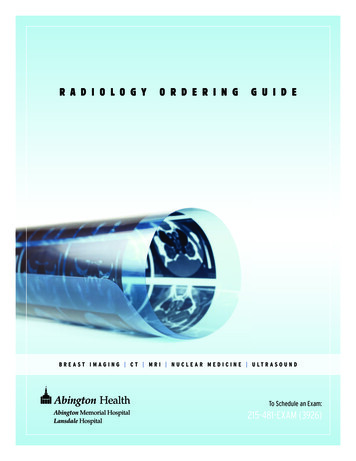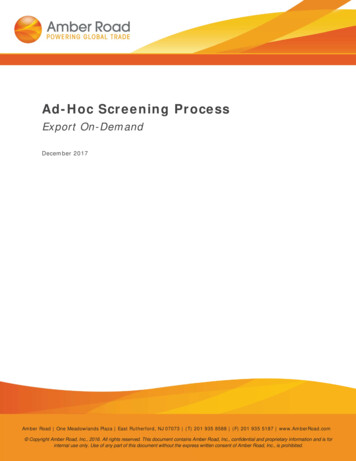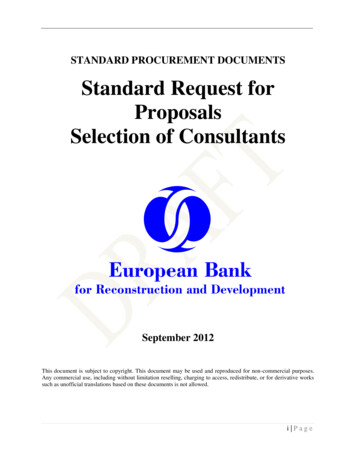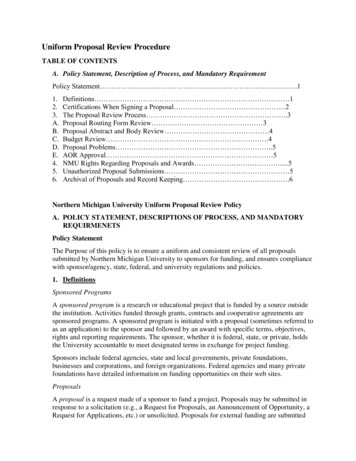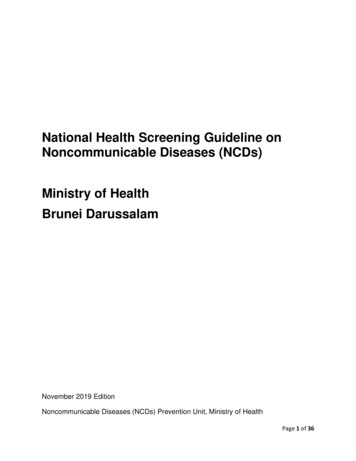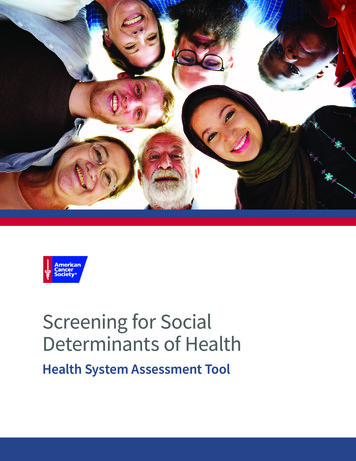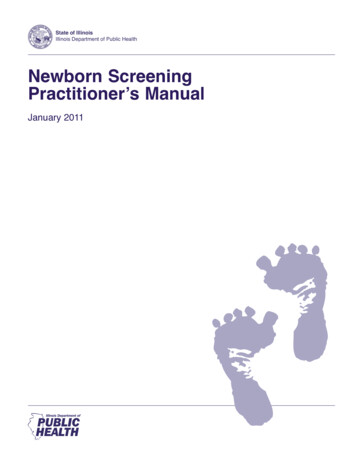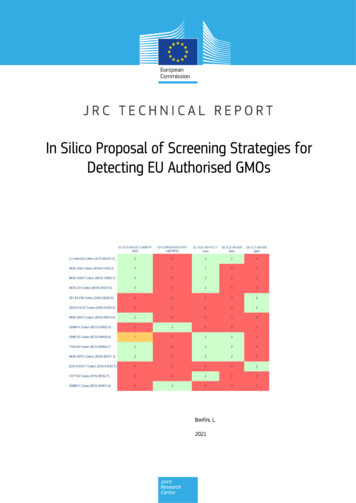
Transcription
In Silico Proposal of Screening Strategies forDetecting EU Authorised GMOsBonfini, L.2021
This publication is a Technical report by the Joint Research Centre (JRC), the European Commission’s science and knowledge service. Itaims to provide evidence-based scientific support to the European policymaking process. The scientific output expressed does not imply apolicy position of the European Commission. Neither the European Commission nor any person acting on behalf of the Commission isresponsible for the use that might be made of this publication. For information on the methodology and quality underlying the data usedin this publication for which the source is neither Eurostat nor other Commission services, users should contact the referenced source. Thedesignations employed and the presentation of material on the maps do not imply the expression of any opinion whatsoever on the partof the European Union concerning the legal status of any country, territory, city or area or of its authorities, or concerning the delimitationof its frontiers or boundaries.Contact informationDG JOINT RESEARCH CENTREDirectorate F - Health, Consumers and Reference MaterialsFood & Feed ComplianceEuropean Union Reference Laboratory for GM Food and FeedVia E. Fermi 2749, 21027 Ispra (VA) – ItalyFunctional mailbox: JRC-EURL-GMFF@ec.europa.euEU Science Hubhttps://ec.europa.eu/jrcJRC127110Ispra: European Commission, 2021 European Union, 2021The reuse policy of the European Commission is implemented by the Commission Decision 2011/833/EU of 12 December 2011 on thereuse of Commission documents (OJ L 330, 14.12.2011, p. 39). Except otherwise noted, the reuse of this document is authorised underthe Creative Commons Attribution 4.0 International (CC BY 4.0) licence (https://creativecommons.org/licenses/by/4.0/). This means thatreuse is allowed provided appropriate credit is given and any changes are indicated. For any use or reproduction of photos or othermaterial that is not owned by the EU, permission must be sought directly from the copyright holders.All content European Union, 2021How to cite this report: Bonfini L., In Silico Proposal of Screening Strategies for Detecting EU Authorised GMOs, European Commission, Ispra,2021, JRC127110.
ContentsDisclaimer .1Acknoledgements .2Abstract .31. Purpose .42. Introduction .53. Screening strategy proposal for detecting EU authorised GMOs . 84. Conclusions .11List of abbreviations and definitions .12List of figures .13List of tables .14Annex .15References .16ii
DisclaimerThe screening proposals are based on in silico predictions and on information available to the authors on 22October 2021. The completeness of this report is limited to this date. Further information on the EUauthorisation of GM Food and Feed can be found on the GMO Register of the European Commission.1
AcknoledgementsThe author would like to thank Wim Broothaerts, Cristian Savini and Francesco Gatto for their feedback andsuggestions.AuthorsLaura Bonfini2
AbstractGiven the high number of GMOs currently authorised or whose authorisation is pending or has expired, it isnecessary to implement an optimised strategy for screening food and feed samples in the EU market. The JRCGMO-Matrix web application, available on the website of the European Union Reference Laboratory forGenetically Modified Food and Feed (EURL GMFF), may help designing such strategies. This web applicationprovides in silico e-PCR predictions of the GM events possibly detected by the EU reference methods in theGMOMETHODS database. By using the JRC GMO-Matrix application, the EURL GMFF proposes in this report,screening strategies for detecting all EU authorised GMOs in samples containing cotton, oilseed rape, maize,soybean or sugar beet. These proposals may contribute to the design of more efficient approaches for EUlegislative enforcement and inspection control.3
1. PurposeScope of this document is to provide a screening proposal for the efficient detection of EU authorised GMOs.The proposal is based on the EU authorisation status of the GM events as displayed on the CommunityRegister of GM food and feed ( 1) on 22 October 2021 and by in silico analyses performed on the same dateon the JRC GMO-Matrix application ( 2).4
2. IntroductionRegulation (EU) No 2017/625 ( 3) states that the European Union Reference Laboratories (EURLs) for feed andfood are responsible, amongst others, for “providing national reference laboratories with details and guidanceon the methods of laboratory analysis, testing or diagnosis, including reference methods”. To that end, theEuropean Union Reference Laboratory for Genetically Modified Food and Feed (EURL GMFF) has developed adatabase of EU reference methods for GMO analysis, called “GMOMETHODS" ( 4) available at https://gmocrl.jrc.ec.europa.eu/gmomethods/ (see Figure 1).Figure 1. GMOMETHODS database home pageThe database contains DNA-based detection methods that have been validated in a collaborative trialaccording to the principles and requirements of ISO 5725 ( 5) and/or the International Union of Pure andApplied Chemistry (IUPAC) ( 6) protocol or that have been verified by the EURL GMFF for EU legal purposes.These methods cover at least all the GMOs that have been authorised in the EU, or whose authorisation ispending or has expired.5
The data outlined in Table 1 provide an overview on the methods included in the GMOMETHODS database upto 22 October 2021. The database offers information on 198 different polymerase chain reaction (PCR)methods covering 148 and 50 assays respectively for GMO and taxon detection. It includes 90 event-specificmethods for identification of 86 single GM events, 35 ‘element-specific’ screening assays and 23 ‘constructspecific’ methods that in some instances can be used for screening purposes.Table 1. GMO and taxon-specific methods included in the GMOMETHODS database according to specificity and purpose ofthe litativePlant-specificTotal 33549175123198These screening assays allow detecting 20 single or combined genetic elements (see Table 2) used in thedevelopment of many GMOs approved worldwide (7).Table 2. Screening targets detected by the EU reference methodsNScreening Target1Cauliflower Mosaic Virus 35S promoterCaMV P-35S2Cauliflower Mosaic Virus 35S terminatorCaMV T-35S3Cauliflower Mosaic Virus 35S terminator from pCAMBIA vectors4CP4 epsps gene from Agrobacterium tumefaciens type I and IICP4-epsps5Cry1Ab/Ac modified genes derived from Bacillus thuringiensiscry1Ab/Ac6Cry1A(b) synthetic gene derived from Bacillus thuringiensis78910Cry1Ac synthetic gene derived from Bacillus thuringiensiscry1AcE9 terminator from Pisum sativumT-E9Figwort Mosaic Virus 35S promoterP-FMVJunction region between the Cauliflower Mosaic Virus 35S promoter and theCaMV P-35S barPhosphinothricin N-acetyl transferase gene from Streptomyces hygroscopicusJunction region between the Cauliflower Mosaic Virus 35S promoter and theCaMV P-35S ptomycesviridochromogenesJunction region between the chloroplast transit peptide 2 sequence from theCTP2 CP4 epspsArabidopsis thaliana epsps gene and the CP4 epsps gene from AgrobacteriumtumefaciensJunction region between the cry1Ab/Ac modified genes and DNA spacer cry1Ab/Ac DNA spacersequencesJunction region between the maize ubiquitin promoter and the cry1Ab/AcP-ubi cry1Ab/Acmodified genesJunction region between the nopaline synthase promoter from AgrobacteriumT-nos nptIItumefaciens and the neomycin phosphotransferase II 1819Neomycin phosphotransferase II geneNopaline synthase promoter from Agrobacterium tumefaciensNopaline synthase terminator from Agrobacterium tumefaciensPhosphinothricin N-acetyl transferase gene from bacterium hinothricin N-acetyltransferase gene from bacterium Streptomycesviridochromogenespat6
According to in silico analyses performed on 22 October 2021 on the JRC GMO-Matrix (2) application (see Figure 2)available on the EURL GMFF website these screening methods may allow detecting 94 % (58/62) of the single GMevents currently authorised in the EU (i) or for which the authorisation procedure is pending or has expired. Only four GMevents could not be detected in silico by screening EU reference methods currently included in the GMOMETHODSdatabase; these were maize DAS-40278-9, oilseed rape 73496 and the two soybean events 305423 and CV127.Detection for these events can be achieved by using only the respective event-specific methods.Figure 2. JRC GMO-Matrix output exampleiGM food and feed authorised under Regulation (EC) No 1829/20037
3. Screening strategy proposal for detecting EU authorised GMOsThe GMOMETHODS database offers in several cases more than one assay for the detection of a GMO or atarget genetic element. Given the high number of GMOs currently authorised or whose authorisation ispending or has expired, it is necessary to implement an optimised strategy for screening food and feedsamples in the EU market. Screening approaches should provide maximal coverage, best performance andminimal cost and laboratory workload. Ideally, they could include additional methods for furtherdiscriminating the GM events possibly detected in the sample. The JRC GMO-Matrix (2) application developedby the JRC may help designing such strategies since it provides in silico e-PCR predictions of the GM eventspossibly detected by the EU reference methods. The computer simulations are performed using primers andprobe sequences from the GMOMETHODS database and GMOs sequences from a JRC internal database. Thelatter includes sequences provided by the applicants for authorisation of GMOs or retrieved independentlyfrom nucleotide/patent databases. The scripts that simulate PCR amplification use "re-PCR" (Rotmistrovsky etal., 2004) ( 8) for detecting potential amplicons in GMO sequences and "matcher" from the EMBOSS package(Rice et al., 2000) ( 9) for verifying probe annealing when the method contains one. An analysis of the in silicoresults can highlight, in principle, which methods could be used for detecting a maximal spectrum ofauthorised GM events for each host species. To that purpose, a bioinformatics analysis was performed on theJRC GMO-Matrix application on 22 October 2021. As a result, Tables 3-7 propose screening strategies fordetecting all EU authorised GMOs ii in samples containing respectively cotton, oilseed rape, maize, soybean andsugar beet. The proposals employ only EU reference methods from the GMOMETHODS database to ensureconsistent and reproducible results in the analyses and cover many assays that are already included on theJRC Pre-Spotted-Plates (PSPs) 10. They are based on in silico predictions and on information available on 22October 2021 and are limited for their completeness to this date. A rationale for the methods selection isprovided in the Annex of this document.In the tables below the methods necessary for detecting for each species all EU authorised GMOs arehighlighted in dark blue color, while those that could further discriminate the possible events present in asample are presented in a lighter blue shade. Methods that are components of a multiplex PCR are combinedunder the same heading specifying the type of PCR assay. The target genetic element is displayed in redbeneath the code of the related EU reference method. In each column, the GMOs that could be detected bythe corresponding method are listed in alphabetical order. Their status of authorisation as of 22 October2021 is highlighted by different colors: green (EU authorised), light green (pending EU authorisation), yellow(subject to a Commission Decision on withdrawal from the EU market) and orange (expired EU authorisation).GMOs for which a detection method has been validated by the EURL GMFF but that are not falling underRegulation (EU) No 619/2011 are marked in bold green text while GMOs that are not authorised in the EU aredisplayed in normal black characters.Table 3. Screening proposal for EU authorised GM cotton eventsDuplex PCRQL-ELE-00-012P-35SQL-ELE-00-013T-nosDuplex 026barSimplex PCRSimplex B119LLCotton25MON 1445MON 15985MON 531MON 88701MON 88913T304-40iiDAS-81910-7GHB119LLCotton25MON 1445MON 15985MON 531MON 88701LLCotton25T304-40T304-40GHB614GHB811MON 1445MON 88701MON 88913GMOs authorised under Regulation (EC) No 1829/20038
Table 4. Screening proposal for EU authorised GM maize eventsDuplex PCRQL-ELE-00-012P-35S15073232316Simplex x *DAS-40278-9GA21MIR162MIR604MON 810MON 863*MON 87403MON 87411MON 863*MON 87419MON 87427MON 87427MON 87429MON 87460MON 88017MON 87460MON 88017MON 89034MZHG0JGMZIR098NK603T25MON 87429MON 89034MZHG0JGMZIR098NK603MZHG0JGMZIR098T25* GMOs also included in the list of products subject to a Commission Decision on withdrawal from the EU marketTable 5. Screening proposal for EU authorised GM oilseed rape eventsDuplex PCRQL-ELE-00-012P-35SQL-ELE-00-013T-nosSimplex PCRSimplex FK (insert 1)LBFLFK (insert 2)MON 88302MS1MS11Oxy-235MS8Oxy-235RF1RF2RF3T45Topas 19/29
Table 6. Screening proposal for EU authorised GM soybean eventsDuplex L-ELE00- 013T-nosSimplex PCRSimplex PCRQL-ELE00-016Cry1Ab/AcQL-ELE00- 024tE9Duplex PCRQL-ELE00- 025patQL-ELE00-026barSimplex PCRSimplex 419-2FG72GMB151*HB4HB4HB4MON 87701MON 87705MON 87708MON 87751MON 87769MON 89788SYHT0H2SYHT0H2SYHT0H2* The primers and probes of the QL-ELE-00-012 method provide experimentally a positive amplification product even if in silico do notperfect anneal to their target in the GM event GMB151.Table 7. Screening proposal for EU authorised GM sugar beet eventsSimplex PCRQL-ELE-00-024tE9H7-1GTSB77LegendGMOs authorised in the EUGMOs with pending authorisation in feed fulfilling the requirements of Regulation (EU) No 619/2011GMOs with an expired authorisationGMOs subject to a Commission Decision on withdrawal from the marketXXXXX GMOs for which a detection method has been validated by the EURL GMFF but not falling underRegulation (EU) No 619/2011XXXXX GMOs not authorised in the EU10
4. ConclusionsIt can be noticed that for some crops, two or three screening methods are sufficient for detecting all relatedauthorised GMOs. For other crops, up to seven methods are necessary for a complete coverage, and in someinstances, event-specific methods are additionally needed for detecting GMOs not covered by the screeningassays. The analytical approaches that are proposed in the tables offer the minimal number of methods fordetecting all EU authorized GMOs in each species. The employment of additional screening methods in thetesting strategy may provide further discriminatory capacity especially in feed but may not be sufficient foruniquely identifying the GM events present in a sample.In the tables some unauthorised GMOs detected by the EU reference methods are also indicated. Their listhowever, is not exhaustive since the JRC GMO-Matrix does not include in silico e-PCR predictions for all GMOsdeveloped or commercialised worldwide. The presence of a non-authorised GMO can be generally presumedwhen the screening results differ from those expected for the EU authorised events finally identified in thesample. Nevertheless, the incidence of a non-authorised GMO can be masked by the concomitant presence ofan authorised GMO presenting similar screening elements. The presence of non-authorised GM events in thefood or feed samples analysed, therefore, cannot be formally excluded.Some sequences targeted by the screening methods are derived from organisms that may be naturallypresent in food and feed samples and may therefore produce false positive results. It is therefore importantto test the food and feed samples in parallel with PCR methods specific for those donor organisms (i.e. for theoccurrence of the Cauliflower Mosaic Virus (CaMV) in samples containing ingredients from Brassicaceae or forcontamination by Agrobacterium species in samples resulting positive to nopaline synthase (nos) terminatorassays. Since the E9 terminator (tE9) element present in many GM events is derived from the pea genome, amethod targeting a pea endogenous gene (i.e. lectin) may also be used in parallel with the E9 assay toexclude the presence of pea derived products in the sample.These screening proposals may be more efficient in enforcing EU GMO legislation and may promote betterharmonisation in the analyses of official control laboratories. Finally, the use of EU reference methods from theGMOMETHODS database following internationally accepted standard protocols may allow global applicability of safetyand trade issues.11
List of abbreviations and definitionsAbbreviationsCaMVCauliflower Mosaic VirusENGLEuropean Network of GMO e synthaseEUEuropean UnionEURLEuropean Union Reference LaboratoryEURL GMFFEuropean Union Reference Laboratory for Genetically Modified Food andFeedGMGenetically ModifiedGMOGenetically Modified OrganismISOInternational Organisation for StandardisationIUPACInternational Union of Pure and Applied ChemistryNosNopaline synthasePCRPolymerase Chain ReactionPSPsPre-Spotted-PlatesJRCJoint Research CentreDefinitionsQualitative methodmethod of analysis whose response is either the presence or absence ofthe target DNA sequence(s) in a sample.Quantitative methodmethod of analysis whose response is the quantity of the target DNAsequence(s) in a sample.Event-specific methodmethod that targets a sequence unique to a single genetic modificationevent (i.e. the fusion sequence composed of the terminal base pairs of theinserted DNA and the adjacent base pairs of the recipient host genome atthe insertion locus).Construct-specific methodmethod that targets an inserted DNA sequence composed of at least twoelements that do not naturally co-exist in this conformation, and where the5’ and 3’ end of the sequence are derived from two separate elements.Element-specific methodmethod that targets a single discrete DNA sequence such as a promoter, aterminator, an intron or the coding part of a gene.Species-specific methodmethod that detects a sequence known to be specific for the target species.Plant-specific methodmethod that detects a sequence know to be specific for the plant kingdom.12
List of figuresFigure 1. GMOMETHODS database home page .5Figure 2. JRC GMO-Matrix output example .713
List of tablesTable 1. GMO and taxon-specific methods included in the GMOMETHODS database according to specificityand purpose of the analysis .6Table 2. Screening targets detected by the EU reference methods .6Table 3. Screening proposal for EU authorised GM cotton events .8Table 4. Screening proposal for EU authorised GM maize events .9Table 5. Screening proposal for EU authorised GM oilseed rape events .9Table 6. Screening proposal for EU authorised GM soybean events . 10Table 7. Screening proposal for EU authorised GM sugar beet events. 1014
AnnexAnnex 1. Rationale for the screening proposalThe screening approaches proposed were determined following the criteria of maximal coverage, bestperformance and minimum laboratory workload. They are based on the results of in silico analyses performedon the JRC GMO-Matrix application on 22 October 2021. A rationale is provided below for the selection of thegenetic targets and corresponding EU reference methods.Most of these methods are already implemented on the Pre-Spotted Plates (PSPs) developed by the JRC forperforming GMO screening analyses. To reduce laboratory workload, two duplex assays for detectingrespectively the P-35S/T-nos and pat/bar elements have been selected in place of the single methods used onthe PSPs. The primers, probes and amplification conditions for targeting the P-35S and T-nos elements in theduplex assay are identical to those of the single methods included on the PSPs. The primers and probestargeting the bar element in the second duplex assay are also identical to the method included on the PSPswhile those for the pat element are different. Both duplex methods could be considered in line with theminimum performance requirements defined in the ENGL document and in particular, with the practicabilitycondition setting the maximum volume of the PCR reactions to 25 µL. To note that the primers and probes ofthe P-35S method provide experimentally a positive amplification product also with the GM event GMB151even if in silico they do not perfectly anneal to their target.The method QL-ELE-00-016 targeting the Cry1Ab/Ac sequences is included in the proposal to allowdetection of soybean GM events MON 87701 and MON 87751. This method is also included on the PSPs. Theonly other EU reference method (QL-ELE-00-020) detecting these soybean events was not selected becauseit is using a SYBR Green approach for amplicon detection.The QT-CON-00-008 method targeting the junction between an optimised transit peptide sequence and thepoint-mutated epsps gene from maize (CTP2-CP4EPSPS) is included in the proposal for detecting the cottonGM events GHB614 and GHB811. These events are not detected in silico by any other screening method.The QL-ELE-00-024 method targeting the tE9 element is included in the proposal for detecting GM sugarbeet H7-1, oilseed rape GT73 and MON 88302 and soybean events MON 89788, MON 87769, MON 87705and MON 87708. All these events are only partially covered by the methods QL-CON-00-008 (included on thePSPs), QL-ELE-00-010 and QL-ELE-00-015, which do not detect soybean events MON 87769 and MON87708.The event-specific method QT-EVE-ZM-004 targeting maize DAS-40278-9 is included in the proposalbecause the event is not detected in silico by any screening EU reference method.The event-specific method QT-EVE-BN-009 targeting oilseed rape 73496 is included in the proposalbecause the event is not detected in silico by any screening EU reference method.The event-specific methods QT-EVE-GM-008 and QT-EVE-GM-011 targeting respectively soybean 305423and CV127 are included in the proposal because these events are not detected in silico by any screening EUreference method.15
ReferencesEU Register of authorised GMOs, European Commission, DG Health andhttps://webgate.ec.europa.eu/dyna/gm register/index en.cfm (accession date 22.10.2021).1FoodSafety.Angers-Loustau, A., Petrillo, M., Bonfini, L., Gatto, F., Rosa, S., Patak, A., Kreysa, J., ‘JRC GMO-Matrix: a webapplication to support Genetically Modified Organisms detection strategies’, BMC Bioinformatics, 15: 417,2014.2Regulation (EU) 2017/625 of the European Parliament and of the Council of 15 March 2017 on officialcontrols and other official activities performed to ensure the application of food and feed law, rules on animalhealth and welfare, plant health and plant protection products. (OJ L 95, 7.4.2017, pp. 1–142).3Bonfini, L., Van den Bulcke, M.H., Mazzara, M., Ben, E., Patak, A., ‘GMOMETHODS: the European Uniondatabase of reference methods for GMO analysis’, Journal of AOAC International, Vol. 95, No 6, 2012, pp.1713–1719.4International Standard ISO 5725, ‘Accuracy (Trueness and Precision) of Measurement Methods and Results’,International Organization for Standardization, Geneva, 1994.5Horwitz, W., ‘Protocol for the design, conduct and interpretation of method-performance studies: revised1994 (technical report)’, Pure & Appl. Chem, Vol. 67, No 2, 2009, pp. 331-343.67Biosafety Clearing-House (BCH). https://bch.cbd.int/ (accession date 22.10.2021).8Rotmistrovsky, K., Jang, W., Schuler, G. D., ‘A web server for performing electronic PCR’, Nucleic AcidsResearch, Vol. 32, 2004, pp. W108–W112.Rice, P., Longden, I., Bleasby, A., ‘EMBOSS: The European Molecular Biology Open Software Suite’, Trends inGenetics, Vol. 16, No 6, 2000, pp. 276-277.9Rosa, S.F., Gatto, F., Angers-Loustau, A., Petrillo, M., Kreysa, J., Querci, M., ‘Development and applicability of aready-to-use PCR system for GMO screening’, Food Chemistry, Vol. 201, 2016, pp. 110–119.1016
GETTING IN TOUCH WITH THE EUIn personAll over the European Union there are hundreds of Europe Direct information centres. You can find the address of the centre nearest you at:https://europa.eu/european-union/contact enOn the phone or by emailEurope Direct is a service that answers your questions about the European Union. You can contact this service:-by freephone: 00 800 6 7 8 9 10 11 (certain operators may charge for these calls),-at the following standard number: 32 22999696, or-by electronic mail via: https://europa.eu/european-union/contact enFINDING INFORMATION ABOUT THE EUOnlineInformation about the European Union in all the official languages of the EU is available on the Europa website at: https://europa.eu/europeanunion/index enEU publicationsYou can download or order free and priced EU publications from EU Bookshop at: https://publications.europa.eu/en/publications. Multiple copies of freepublications may be obtained by contacting Europe Direct or your local information centre (see https://europa.eu/european-union/contact en).
This publication is a Technical report by the Joint Research Centre (JRC), the European Commission's science and knowledge service. It aims to provide evidence-based scientific support to the European policymaking process. The scientific output expressed does not imply a policy position of the European Commission.

